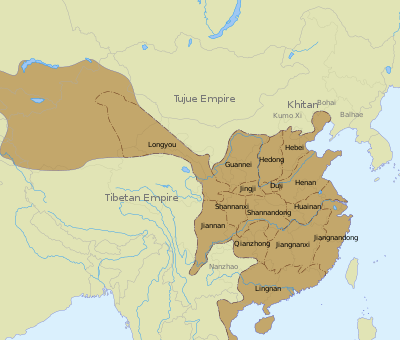Circuit (administrative division)
A circuit (Chinese: 道; pinyin: dào or Chinese: 路; pinyin: lù) was a historical political division of China and is a historical and modern administrative unit in Japan. The primary level of administrative division of Korea under the Joseon and in modern North and South Korea employs the same Chinese character as the Chinese and Japanese divisions but, because of its relatively greater importance, is usually translated as province instead.
| Circuit | |||||||||||
|---|---|---|---|---|---|---|---|---|---|---|---|
 The inspection circuits of the Tang dynasty in 742[1] | |||||||||||
| Dao (mainly Tang dynasty) | |||||||||||
| Chinese | 道 | ||||||||||
| Literal meaning | way, path, circuit | ||||||||||
| |||||||||||
| Lu (Song and Jin dynasties) | |||||||||||
| Chinese | 路 | ||||||||||
| |||||||||||
| Korean name | |||||||||||
| Hangul | 도 | ||||||||||
| Hanja | 道 | ||||||||||
| |||||||||||
| Japanese name | |||||||||||
| Kanji | 道 | ||||||||||
| Kana | どう | ||||||||||
| |||||||||||
China
| "Circuit" | |||
|---|---|---|---|
| Period | Chinese | Pinyin | Level |
| Han | 道 | dào | 3rd |
| Tang, Liao | 1st | ||
| Song, Jin | 路 | lù | |
| Yuan | 道 | dào | 2nd |
| Qing, ROC (12-28) | |||
| ROC (32-49) | 行政督察區 | xíngzhèng dūchá qū | |
Circuits originated in China during the Han dynasty and were used as a lower-tier administrative division, comparable to the county (simplified Chinese: 县; traditional Chinese: 縣; pinyin: xiàn, also translated as "districts"). They were used only in the fringes of the Empire, which were either inhabited primarily by non-Han Chinese peoples or too geographically isolated from the rest of the Han centers of power. The system fell into disuse after the collapse of the Western Jin dynasty.
The administrative division was revived in 627 when Tang Emperor Taizong made it the highest level administrative division and subdivided China into ten circuits. These were originally meant to be purely geographic and not administrative. Emperor Xuanzong added a further five, and slowly the circuits strengthened their own power until they became powerful regional forces that tore the country apart during the Five Dynasties and Ten Kingdoms period. During the Song and Jin dynasties, circuits (“dao”) were renamed lu (路), both of which mean "road" or "path".
Dao were revived during the Yuan dynasty. Circuits were demoted to the second level after the Yuan dynasty established provinces at the very top and remained there for the next several centuries. The Yuan dynasty also had lu (sometimes translated as "route"), but it was simply the Chinese word used for the Mongolian administrative unit, the cölge. The Yuan lu had little to do with the circuits (lu) in the Song and Jin dynasties and were closer in size to prefectures.[2]
Under the Qing, they were overseen by a circuit intendant or tao-tai (Chinese: 道臺; pinyin: dàotái). The circuit intendant of Shanghai was particularly influential.
During the Republic of China era, circuits still existed as high-level, though not top-level, administrative divisions such as Qiongya Circuit (now Hainan province). In 1928, all circuits were replaced with committees or simply abandoned. In 1932, administrative circuits (Chinese: 行政督察區; pinyin: xíngzhèng dūchá qū) were reintroduced and lasted until 1949.
In 1949, after the founding of the People's Republic of China, all the administrative circuits were all converted into zhuangqu (Chinese: 专区; pinyin: zhuānqū) in 1949 and renamed diqu (Chinese: 地区; pinyin: dìqū; lit.: 'prefecture') in the 1970s.
Japan
During the Asuka period (538–710), Japan was organized into five provinces and seven circuits, known as the Gokishichidō (5 ki 7 dō), as part of a legal and governmental system borrowed from the Chinese.[3] Though these units did not survive as administrative structures beyond the Muromachi period (1336–1573), they did remain important geographical entities until the 19th century. The seven circuits spread over the islands of Honshū, Shikoku, and Kyūshū:
- Tōkaidō (東海道) "East Sea Circuit": 15 provinces (kuni)
- Nankaidō (南海道) "South Sea Circuit": 6 provinces
- Saikaidō (西海道) "West Sea Circuit": 8 provinces
- Hokurikudō (北陸道) "North Land Circuit": 7 provinces
- San'indō (山陰道) "Shaded-side Circuit": 8 provinces
- San'yōdō (山陽道) "Sunny-side Circuit": 8 provinces
- Tōsandō (東山道) "East Mountain Circuit": 13 provinces
In the mid-19th century, the northern island of Ezo was settled, and renamed Hokkaidō (北海道, "North Sea Circuit"). It is currently the only prefecture of Japan named with the dō (circuit) suffix.
Korea
Since the late 10th century, the do (“province”) has been the primary administrative division in Korea. See Eight Provinces, Provinces of Korea, Subdivisions of South Korea and Administrative divisions of North Korea for details.
See also
References
- Cambridge History of China.
- Buell, Paul D. (2003). The A to Z of the Mongol World Empire. Scarecrow Press. pp. 141, 188. ISBN 978-0-8108-7578-4.
- Nussbaum, Louis-Frédéric. (2005). "Goki-shichidō" in Japan Encyclopedia, p. 255, p. 255, at Google Books; n.b., Louis-Frédéric is pseudonym of Louis-Frédéric Nussbaum, see Deutsche Nationalbibliothek Authority File.
